
eBook - ePub
The Modern Chair
Classic Designs by Thonet, Breuer, Le Corbusier, Eames and Others
Clement Meadmore
This is a test
Buch teilen
- 192 Seiten
- English
- ePUB (handyfreundlich)
- Über iOS und Android verfügbar
eBook - ePub
The Modern Chair
Classic Designs by Thonet, Breuer, Le Corbusier, Eames and Others
Clement Meadmore
Angaben zum Buch
Buchvorschau
Inhaltsverzeichnis
Quellenangaben
Über dieses Buch
In this profusely illustrated study, a noted furniture designer brings together more than 40 examples of chairs that combine practicality and elegance to transcend the confines of period and fashion. Featured are such modern `classics` as Thonet's Bentwood armchair, Breuer's Wassily chair, van der Rohe's Barcelone chair, and many more.
Each chair is described in detail with the aid of photographs, Mr. Meadmore's own explanatory drawings and some reproductions of the original designers' plans. The author also explores the ways in which the designers approached and solved inherent problems of function and aesthetics. The scale drawings in this book are all one-eighth of full size, allowing easy assessment of dimensions and visual comparison of size and proportion.
Many of these chairs are housed in museum collections; others are still being produced today. Now, this inexpensive edition of The Modern Chair enables students of furniture and any interested reader to make a thorough study of the most important chairs of modern times.
Each chair is described in detail with the aid of photographs, Mr. Meadmore's own explanatory drawings and some reproductions of the original designers' plans. The author also explores the ways in which the designers approached and solved inherent problems of function and aesthetics. The scale drawings in this book are all one-eighth of full size, allowing easy assessment of dimensions and visual comparison of size and proportion.
Many of these chairs are housed in museum collections; others are still being produced today. Now, this inexpensive edition of The Modern Chair enables students of furniture and any interested reader to make a thorough study of the most important chairs of modern times.
Häufig gestellte Fragen
Wie kann ich mein Abo kündigen?
Gehe einfach zum Kontobereich in den Einstellungen und klicke auf „Abo kündigen“ – ganz einfach. Nachdem du gekündigt hast, bleibt deine Mitgliedschaft für den verbleibenden Abozeitraum, den du bereits bezahlt hast, aktiv. Mehr Informationen hier.
(Wie) Kann ich Bücher herunterladen?
Derzeit stehen all unsere auf Mobilgeräte reagierenden ePub-Bücher zum Download über die App zur Verfügung. Die meisten unserer PDFs stehen ebenfalls zum Download bereit; wir arbeiten daran, auch die übrigen PDFs zum Download anzubieten, bei denen dies aktuell noch nicht möglich ist. Weitere Informationen hier.
Welcher Unterschied besteht bei den Preisen zwischen den Aboplänen?
Mit beiden Aboplänen erhältst du vollen Zugang zur Bibliothek und allen Funktionen von Perlego. Die einzigen Unterschiede bestehen im Preis und dem Abozeitraum: Mit dem Jahresabo sparst du auf 12 Monate gerechnet im Vergleich zum Monatsabo rund 30 %.
Was ist Perlego?
Wir sind ein Online-Abodienst für Lehrbücher, bei dem du für weniger als den Preis eines einzelnen Buches pro Monat Zugang zu einer ganzen Online-Bibliothek erhältst. Mit über 1 Million Büchern zu über 1.000 verschiedenen Themen haben wir bestimmt alles, was du brauchst! Weitere Informationen hier.
Unterstützt Perlego Text-zu-Sprache?
Achte auf das Symbol zum Vorlesen in deinem nächsten Buch, um zu sehen, ob du es dir auch anhören kannst. Bei diesem Tool wird dir Text laut vorgelesen, wobei der Text beim Vorlesen auch grafisch hervorgehoben wird. Du kannst das Vorlesen jederzeit anhalten, beschleunigen und verlangsamen. Weitere Informationen hier.
Ist The Modern Chair als Online-PDF/ePub verfügbar?
Ja, du hast Zugang zu The Modern Chair von Clement Meadmore im PDF- und/oder ePub-Format. Aus unserem Katalog stehen dir über 1 Million Bücher zur Verfügung.
Information
Verlag
Dover PublicationsJahr
2014ISBN
9780486142692
Part 1 Classics
The classic chairs, for the purpose of this book, are those designed between the beginnings of the modern movement and the Second World War and which survive in production to the present day. Within this area I have selected those which I consider to be innovative and influential in a positive way. In most cases they were the first examples of what has now become a familiar type in the idiom of modern furniture.
I have included more than one example of cantilever chairs, partly because it is not absolutely clear which was the first of its kind, and because they each show significant differences, in rationale and aesthetic. Mies van der Rohe, for instance, thought of the cantilever primarily as a graceful spring, whereas Marcel Breuer saw it as a simplification of the old idea of four legs (p. 47). Alvar Aalto, on the other hand, was involved with the exploitation of the potential of newly available laminated wood, with its great strength in curved configurations (p. 85).
The other classics included here nearly all show interesting affinities with contemporary fine art movements, showing the extent to which their designers were involved with painters, sculptors and industrial and graphic artists of their own time, Rietveld’s chairs (pp. 36, 93, 154) are closely connected with De Stijl; Breuer’s express the Bauhaus aesthetic (p. 53). Tatlin’s chair is related to his constructivist sculpture, and to his experiments with the basic laws of structure (p. 49). Riemerschmid was a member of the Art Nouveau movement, and its urbane atmosphere permeates the detailing of his chair (p. 25).
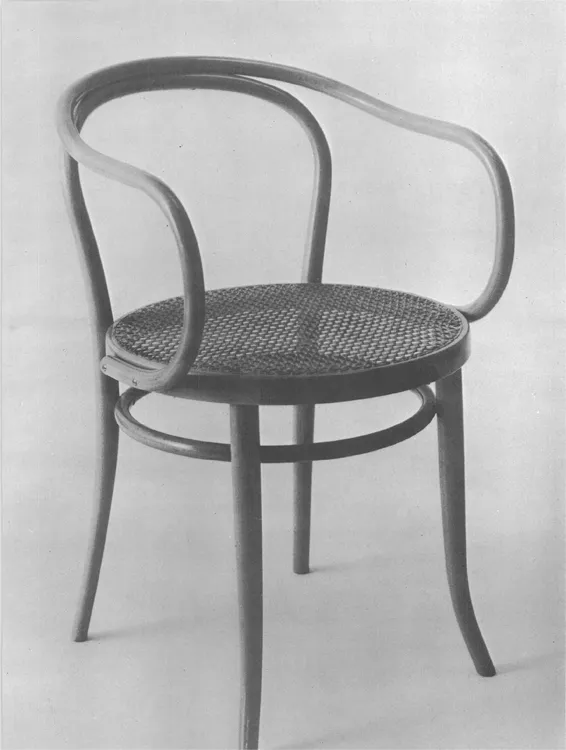
Bentwood armchair
Michael Thonet
Austria, 1870
In 1840 Michael Thonet invented a process for bending wood which revolutionized the mass production of furniture. He soon established a range of bentwood chairs and other furniture running into hundreds of variations, of which the example shown here is perhaps the most elegant. His patented process consisted of clamping a thin flexible strip of steel along one side of a piece of steamed wood. This side, after bending, became the outside of the curve. Without steel, compression of the inner edge and tension on the outer would result in the outside cracking on the curve. This simple process enabled Thonet to use extremely tight structural curves, just as strong or even stronger than the wood in its normal state before treatment. Another result was the elimination of virtually all complex jointing in the construction, as elements could be lapped over one another and joined with screws.
The armless side chair, introduced in 1876, was chosen by Adolf Loos for use in his buildings. Le Corbusier, however, selected the armchair, and the two architects were said to have had an argument in which each accused the other of having chosen the wrong one. The side chair has certainly been the more extensively mass-produced, in fact by 1900 about 40,000,000 had been manufactured.
The beautiful curves of the Thonet chairs, dictated by the intrinsic qualities of the material, were echoed by the Art Nouveau movement in which the same plant-like curves were used; but Thonet preceded the Art Nouveau style by some forty years. Bentwood had been used since the 18th century for the backs of rural, craft-built chairs – typically the Windsor type – but only a rather strained and gradual curve was possible before Thonet’s process. The patents ran out a few years ago on the original patterns, and now there are several manufacturers copying the designs and developing others which employ the same principles. There are certain tubular metal chairs, for instance the Armchair 12 by Poul Kjaerholm (p. 138}, that owe something to the general configuration of a Thonet chair, partly because the similar diameter and visual weight of the two materials dictate similarly appropriate curves. The Thonet chair uses wood expressively in its most natural-looking form, invoking the way it originally appears in trees – as a springy, pliant material supporting its load without resort to bulk and without strengthening joints. These chairs have been so widely distributed and have become so much part of our lives that it is difficult to judge them objectively. However, one can safely say that they are among the most beautiful man-made objects in our environment, and that familiarity never seems to detract from their appeal.
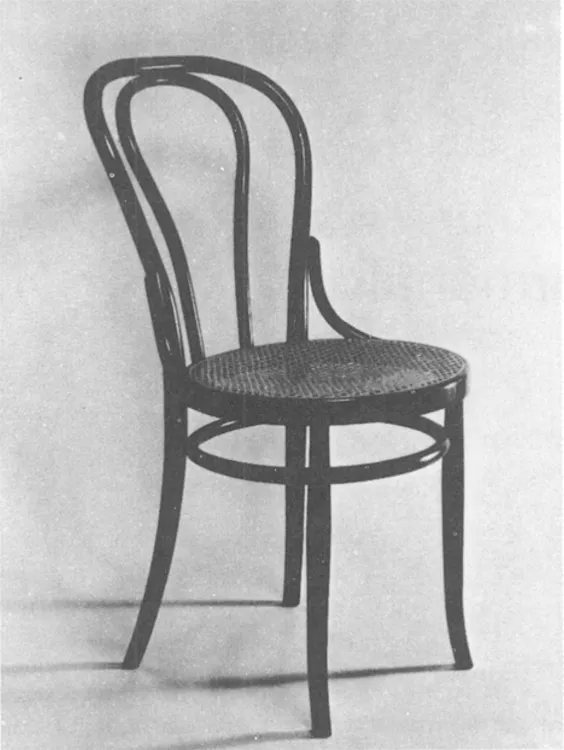
Armless chair.

Colonial chair
Designer unknown
Mid-nineteenth century
This chair was originally designed to be used by British army officers in India. They needed a chair that was light in weight, could be folded up and carried around easily, could be used on uneven terrain without breaking and was reasonably comfortable. This was achieved by constructing the chair from a series of turned oak parts which were fitted into each other loosely and were not glued, being held together by a combination of leather straps and leather or canvas seat and back. The straps, arms, seat and back all acted under tension to keep the structure in place, while allowing it to adjust to uneven ground. The Colonial chair had no significant antecedents except early peasant rush seats which used round rods as stretchers which fitted into holes in the legs. The two classic derivations from this chair are Marcel Breuer’s Wassily chair of 1925 (p. 41) and Le Corbusier’s Basculant chair of 1928 (p. 61).
There are many variations on this chair made in different parts of the world, but most look rather weak in comparison with the original. The Colonial chair looks what it is, a strong, functional, work-horse of a chair, capable of roughing it out of doors and virtually lasting for ever. All its elements express their function perfectly - they are simple and direct. All parts are constructed at right angles, the angle of the seat is made by stretching the canvas or leather from front to back on two bars which are mounted at different heights, and the backrest is arranged on two pivoted strips of wood. All in all a very satisfying chair to look at, if not totally satisfying to sit in.
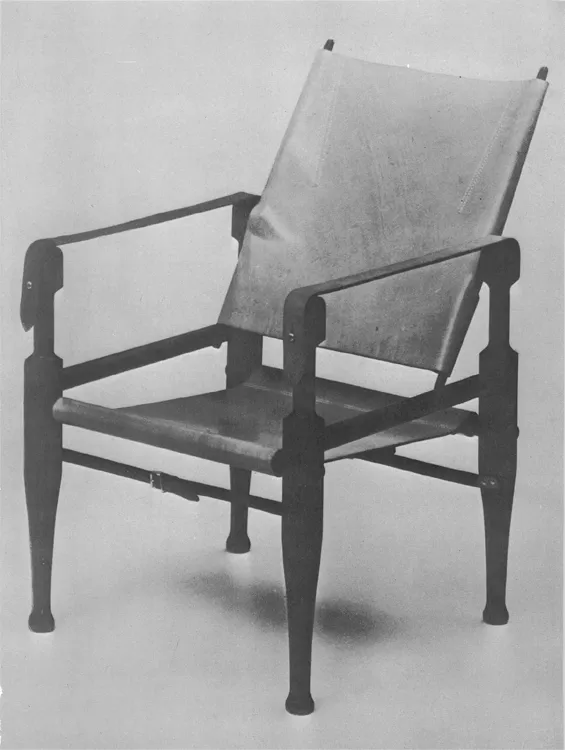
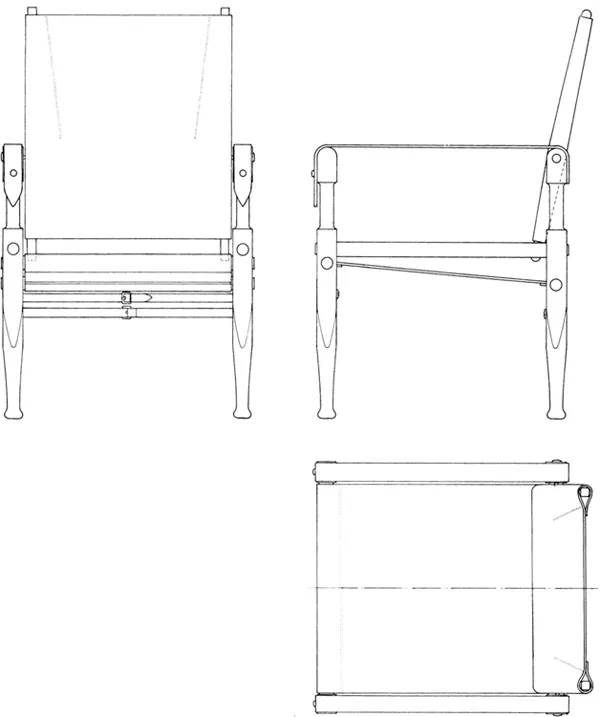
The design of these chairs was probably influenced by the colonial chair (see pages 40 and 60).
Wassily chair by Marcel Breuer
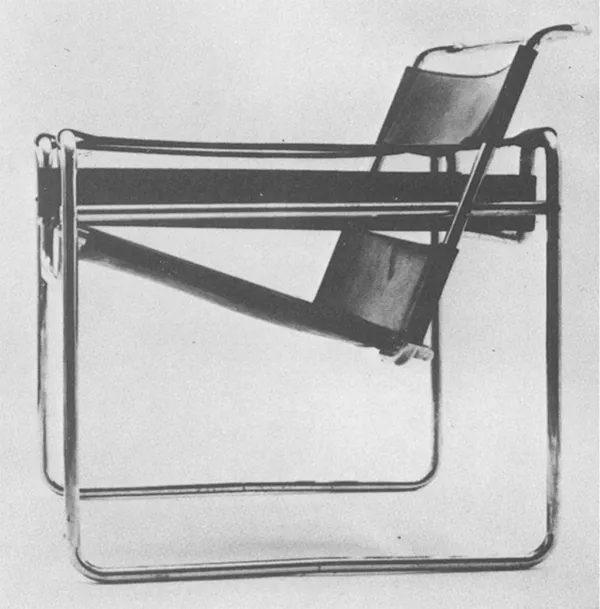
The Basculant by Le Corbusier
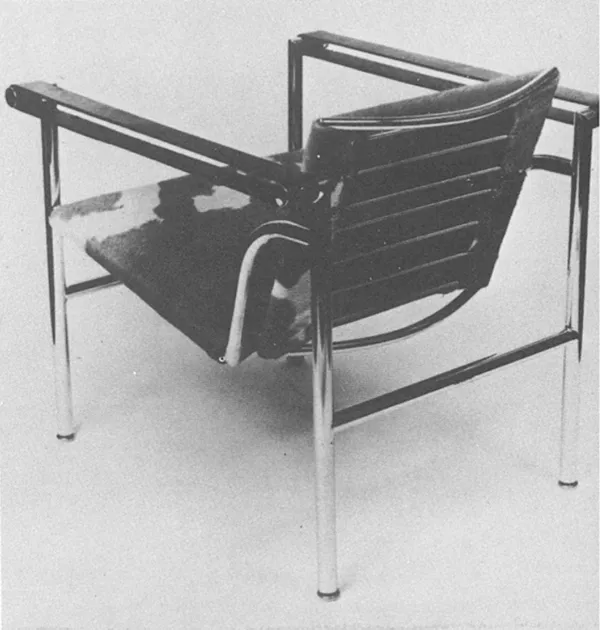

Tripolina
Joseph Beverly Fenby
England, 1877
This design was patented by Joseph Fenby, an inventor, in 1877. The chair was later manufactured in Italy as the Tripolina, and in the United States as the Gold Medal No. 4. This is a prototype from which a number of similar designs have sprung, notably the Hardoy chair designed in 1940 by the Argentinian architects Antonio Bonet, Juan Kurchan and Ferrari Hardoy.
The Tripolina’s popularity with circus clowns and army officers on campaigns stems from its unsurpassed collapsibility – setting it up involves simply pulling it open and draping it with its seat/back sling. It is interesting that Fenby regarded his chair as an afterthought, and a stool with the same structure as...